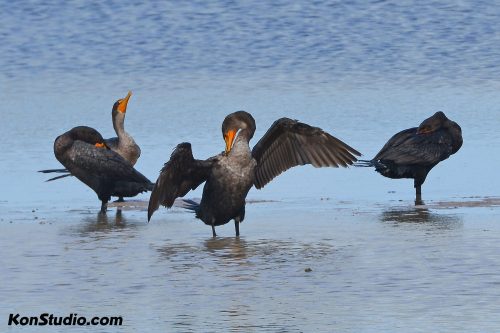The Double-crested Cormorant is also known as The Sea Raven. Cormorant is derived from the Latin word Corvus, which means raven, and Marinus, which means sea.
Cormorants (Phalacrocorax auritu) are brownish-black with black webbed feet and legs and a reddish-orange face and beak. You will often find them floating low in the water or with their wings outstretched along the shores of coastal areas, rivers, swamps, and lakes. Because their oil glands do not waterproof their rings, cormorants will find a sunny spot to dry their wings.
Cormorants may feed alone or in flocks. Finding their favorite foods, fish, and invertebrates, like shrimp and crabs, may require them to dive up to 60 feet and remain submerged for more than a minute. Cormorants are not picky eaters, and their diets vary by season. They enjoy treats such as eels, plants, frogs, and an occasional snake.
Courtship is a big deal for Sea Ravens. A Male will use his wings to splash, swim in zig-zag patterns, and dive for vegetation to present to a female. He will crouch at his chosen nest site and call out to his desired female while vibrating his wings. Nesting usually takes place in a large colony, which is sometimes shared with other wading birds. Using twigs, sticks, seaweed, and grass collected mostly by the male, the female constructs most of the nest in a tree or on the ground near the water. Cormorants incubate their 3-4 eggs with their webbed feet. Both the male and female will feed the chicks until they are about 10 weeks old and ready to leave the nest.
Before 1966 populations significantly decreased from hunting and pesticides such as DDT. Today, cormorants are once again widespread and abundant. This heartwarming story of the Sea Ravens, who not only survived persecution from humans but who are now thriving, can be repeated with today’s endangered and threatened animals. It’s up to us to teach folks of all ages to connect, respect, and coexist with our wildlife and within our shared ecosystems.

